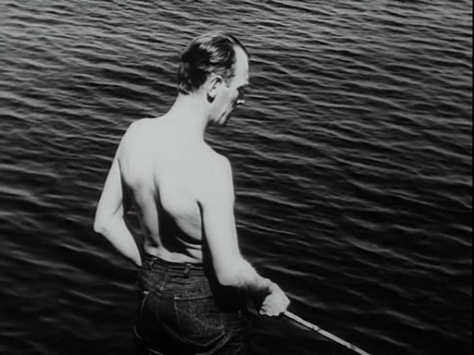
PART FOUR OF MY BERGMANIA
Vargtimmen / Hour of the Wolf
Another dissimilar film by Ingmar, Hour of the Wolf is a very closeted and gothic tale about the growing anxiety of a once happy couple in Johan (Max von Sydow) and Alma (Liv Ullmann).
The film opens on Alma speaking to a camera about her life with Johan, his diary and the pain she endured being with him during his more radical and frightening stages. Johan and Alma started living a normal life together – he was a painter and she was just there in love with him. They moved to a solitary, quaint home in the village as Johan doesn’t like the company of other people. With adjacent personalities, Alma grows more and more worried about the desolate romance her and Johan are participating in. With Johan’s anxiety growing more and more unmanageable – him painting real monsters that include an old woman who takes off her face when she takes off her hat – Alma is sent into a tizzy. One day, an old woman that mistakes her age of 67 with 217 tells Alma to go through Johan’s satchel and read his diary. After reading about his longing for his former love, Veronica Volger and other unyielding encounters with monsters, Alma becomes post-manic and frantic in her outlook of romance and Johan. She begins to grow desperate to look for things that separate her and Johan, while at the same time looking for things that bring them closer together; an instance would be the very disheartening scene in which Alma tries to hold a mundane conversation with Johan about their monthly expenses.
On another random occurrence, Johan meets with one of the neighbours who offers him to come over to their castle for a party. At the party, Johan is ridiculed for being an artist and he replies with one of the most potent and well-crafted responses to a patronizing question. This gives Johan depth and proves he is as intelligent as he is stoic.
With hatred for company, Johan insists that he and Alma leave – and they do so. Shortly after, Johan begins to open up about his relationship with his childhood and how it torments him – him being caned as a child, for example. Through miserable and disturbing metaphor, Bergman crafts Johan’s attempted suppression of his childhood.
Later on, the film takes a grim turn and becomes chilling and claustrophobic. The film uses birds greatly to foreshadow mortifying events and does so best in the closing quarter. Johan’s greatest fears become realities – you become compassionate for the man who is internally fragmented. The rest of the film is as relentless, closing with Alma’s final entry to the people documenting this event and ending with Alma as a lost soul and a much less complete person as the film insisted at the beginning, or Johan spoke of in past times.
What makes this film such an interesting tale is that it works on two levels perfectly. It works on the mental level that entices the viewer to think heavily about the story at hand and the symbols being mulled around, but it also works as a typical gothic tale that is horrifying in its own right. The metaphor scene I talked about earlier can add onto the face-value horror tale, as the child in the frame is a “cannibal”. This is Bergman’s most precise directorial effort, and although it isn’t my favourite story of his, the work behind the camera certainly makes up for any continuity placed in front of it. [9/10]